|
Written By:
Date Posted: February 18, 2002
The Test Bed
AMD Athlon Thunderbird 1.4GHz (1.75v), w/Vantec CCK-6027D
Abit KT7A-RAID, with socket thermal sensor touching the bottom of the CPU
Antec SX630 Case
Room temperature is maintained at ~23C/74F
The system above is my day to day network server, since I'm not currently LANning. I loaded up Seti, and let it run pretty much 24/7, and only checked the computer when I needed a temperature check. I'll be including scores from the last batch of compounds as a comparison to the newer ones.
AMD Athlon XP 1800+ (1.75v), w/Swiftech MCX462
Abit KG7-RAID, with socket thermal sensor touching the bottom of the CPU
Lian-Li PC60
Room temperature is maintained at ~23C/74F
This is my everyday rig, and where it'll be powered on and off to mimic the real-world use of most computers. I do all my gaming on this machine, as well as my web work, so I think it'll get a fair workout. This is also where we'll be testing the video card GPU temperatures.
As usual, testing conditions vary from user to user, and I've done my best to maintain a consistent testing environment. My results may or may not be similar to your own.
MSI StarForce 822 GeForce 3
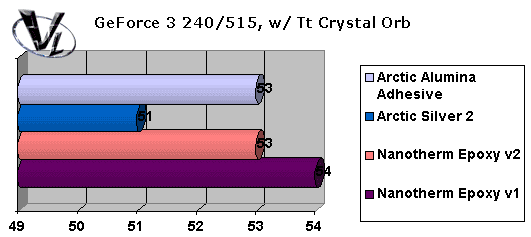
We're starting with the video card temps first, since there isn't as much to talk about. I'm only including overclocked, full load results here, because if it can handle these speeds, and this amount of work, you'll be just fine.
Both the new version of the Nanotherm Epoxy and Arctic Alumina Adhesive slightly improve upon the previous version of the Nantherm Epoxy I used before. I had some problems applying the epoxies (both of them), which may contribute to the difference between those and the Arctic Silver 2. For the record, if you're the type to try out a bunch of GPU heatsinks, I think these epoxies would be better suited for things such as ram chips, motherboard chipsets, or for attaching anything you don't intend to remove often. Even though I diluted the mixtures, they were freaking hard to get off. Had I not done so, it may have improved the performance, but I never would have gotten the Crystal Orb off.
CPU Temperature Benchmarks
We'll begin with the Athlon 1.4GHz numbers, which will be running Seti@Home for the week of testing. The only time it'll be stopped is just for the temperature check.
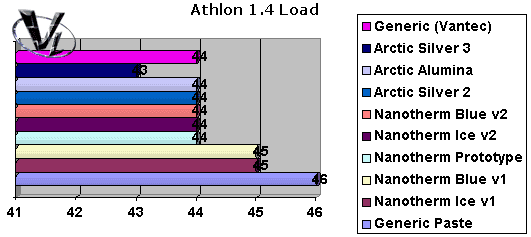
The Thunderbird is a hot running chip, and should provide a challenge to any heatsink or compound around. As we can see above, there isn't much difference between the compounds, although the Arctic Silver 3 does pull ahead. I've included scores from our last roundup for comparison. It was interesting to see the new Nanotherms perform like the Nanotherm Prototype we looked at last time. This would lead me to believe they're similar, if not the same product.
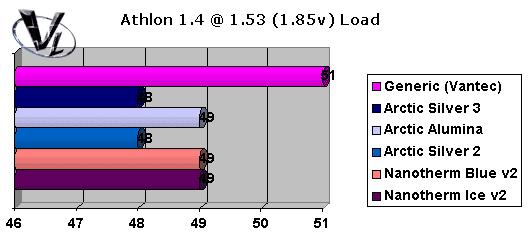
I decided that we may as well overclock the chip to 11.5x133, and up the voltage to give a better workout. All the compounds do perform closely, but we see the gap widen between the silver compounds and the Vantec generic.

Allowing for a break-in period, we notice that temperatures seem to get lower by about one degree for all the compounds. I was a bit wary about this, as one degree falls within our margin of error, so we'll hold judgement until we view the Athlon XP results.
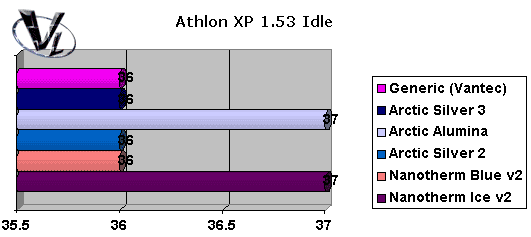
Before some of you freak out with the size of those graphs, remember that this is just one degree. As we've seen with the Thunderbird, temperatures fall within a degree of one another when idle.
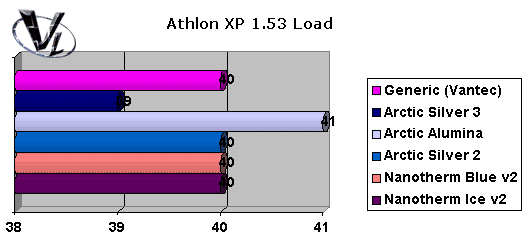
Here, we see the Arctic Silver 3 holding strong in the lead, but all the others are close behind. The Alumina is trailing though, and this wasn't something I expected.
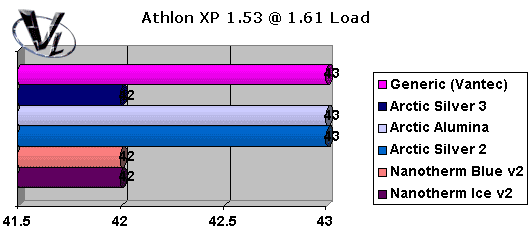
Pushing the XP to 11.5x140 forces everything to work a little harder. Both new versions of the Nanotherm hold the lead position with the Arctic Silver 3. Again, the difference between the leaders and the others differ by only a degree.
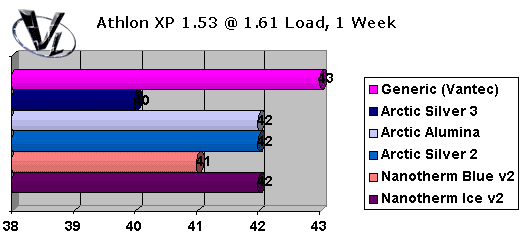
Allowing for the break-in period, everyone settles in on their final scores. Conclusion? Keeping in the Olympic theme, Arctic Silver 3 is our new gold medalist, with Nanotherm sharing silver with Alumina, and bronze finish by Vantec's tube of generic.
Final Words
Before getting to each product individually, I want to answer a few questions that I'm sure is going to be asked. Do these compounds really perform a lot better than regular paste, and is it worth it? To answer the first question, these exotic compounds don't really improve performance to a point that overclocking will become easier. Arctic Silver 3 does produce better numbers than the rest, but one degree may not be a big deal for some. As for the second question, both Nanotherm and Arctic Silver have lowered their prices since we last looked at them, but their products do cost more than the paste you probably got for free. The flip side though, that free paste isn't resealable, and is basically only used once. Change your CPU, you're still going to have to buy paste. You can buy a tub of grease of course, but I don't see why anyone needs that much, and what I liked about all these products, the syringes make for easy application.
: ESG Associates does live up to their claim that they've improved their Nanotherm products. It has also gotten bigger and cheaper. You can find a list of at their site. Between the two, my preference is the Blue. I found it easier to apply, and the consistency seems smoother than the Ice. The Nanotherm Epoxy was easy to work with and a worthy addition to the Nanotherm product line. I didn't like the packaging much for all the products though, as the plastic used for the syringes can crack if you accidently step on it, or if you did like I did, and shove it into a tool box full of heatsinks, and run to the car.
 
Ice (left), Blue (right)
: This isn't any regular paste. I found the product the easiest to apply and the easiest to clean. It doesn't perform up to Arctic Silver 3 levels, but it isn't supposed to. The texture was creamy, making for even applications a snap. The was also easy to work with, but I did find that it hardened a little slower than the Nanotherm.

: Great performer (really!), and easy to apply. The consistency is similar to the Alumina, and applying it evenly shouldn't be a problem. What I didn't like, which probably applies to all silver compounds, is that it can get messy. Cleaning it isn't easy, and it you get some on your hands without realizing it, you'll end up tracking silver fingerprints all over the place. A small price to pay for the performance though.

None of the reviewed products here contain any silicone, so they should not break down over time. All the products perform comparably, and are highly recommended by us. They don't blow away some of the better generic compounds, but they are packaged better, and given what I've seen, perhaps maintain their level of performance for longer periods of time.
I'd like to thank , and for the review samples.
All products are:

Agree? Disagree? Discuss it in our forums
<<Prev
Home>>
|


